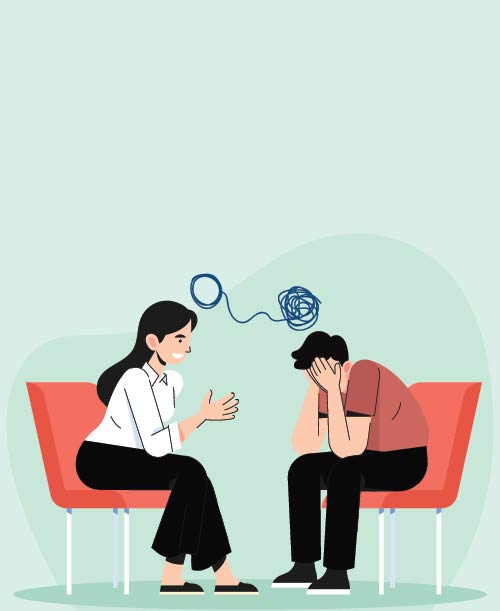

Safety Plan for Suicide Prevention
Suicidal thoughts can bring-down a person’s morale and lower their interest for leading a happy life.Experiencing such thoughts is to experience the feeling of hopelessness, absolute darkness, and pain, which seems to linger and doesn’t go away.While emergency room is an appropriate level of care in times of immediate crisis, co-developing a safety plan for suicide prevention is very important. Read on to learn more about this.
What is a Safety Plan?
A suicide prevention safety plan is a document that supports and guides someone who is experiencing suicidal thoughts, to help them avoid a state of intense suicidal crisis. This plan does not need any professional help and can be drafted by anyone sharing a close-knit relationship with the person considering suicide. The main points included in the plan are:
● Warning signs that trigger the suicidal thoughts in the person
● Coping strategies that have worked for them in the past
● Strategies they think may help them cope in future
● People who can be of support during these times (family members, close friends, professionals)
● Eliminate ways through which suicide can be committed from their environment
● Personal reasons that inspires them to live or helps them to stay alive
When is a Safety Plan Written?
A suicide preventionsafety plan is written when the person has hope for life and is not experiencing any intense suicidal thoughts, so that they can identify their reasons for living, and positive actions they can take to prevent their thoughts from becoming intense Drafting a plan when a person is experiencing suicidal thoughts can make the individual overwhelmed and result into confusion.
A safety plan can be developed in one sitting by the person with thoughts of suicide together with their caregiver or friend, or over time. The plan can change as the circumstances for the individual changes and can be revised accordingly.
Why Does it Work?
A safety plan is designed to focus on a person’s strengths wherein their unique abilities are identified and emphasized so that they can draw positivity from them when their suicidal thoughts become intense. The safety plan is organized in stages. It starts with the coping strategies an individual can implement by themselves at home and ends with 24/7 emergency contact numbers which can be used when there is imminent danger or crisis. When implemented, safety plans become self-strengthening because the person knows that they have weathered such thoughts before and have navigated their way out.
Safety Plan
A person need not be a qualified mental health professional in-order to write a suicide prevention safety plan. The plan can be drafted by a friend, a concerned relative, care-giver, or anyone who is close to the individual experiencing suicidal thoughts. Go over each step together, thoroughly and thoughtfully, and identify the potential safety plan items for the person.
How to Implement a Safety Plan
It is important that the safety plan is implemented and in order to ensure that the safety plan copies should be kept handy and in an accessible place so that the person can always find it when they are experiencing intense thoughts of suicide.
To know on the success of the suicide preventionsafety plan, follow up with the person on a regular basis to ensure he is going through the points.
Is Safety Plan the Same as a No-suicide Contract?
No, both of these are not same. A no-suicide contract is a formal agreement drawn up between a healthcare practitioner and a patient who has suicidal thoughts. Whereas, a safety plan is a word of assurance that provides a ring of support around the patient and is based on a relationship of understanding and trust. Hence a safety plan is seen to be more effective than a no-suicide contract.
Conclusion
A suicide prevention plan is a good way in which suicidal thoughts can be prevented. If you know someone who is going through a tough time then help them draft a safety plan by keeping all the above-mentioned points in mind.
Disclaimer: This blog provides general information and discussions about health and related subjects. The information and other content provided in this blog, website or in any linked materials are not intended and should not be considered, or used as a substitute for, medical advice, diagnosis or treatment. Kindly contact your Doctor before starting a new medicine or health regime.
Related Articles
World Suicide Prevention Day: A Few Tips To Take Care Of Your Mental Health
8 Depression Facts You May Not Know About
Mental Stress Can Affect Your Body – Find Out How
Published on September 09, 2022

















 Health Insurance
Health Insurance  Travel Insurance
Travel Insurance  Car Insurance
Car Insurance  Cyber Insurance
Cyber Insurance  Critical Illness Insurance
Critical Illness Insurance
 Pet Insurance
Pet Insurance
 Bike/Two Wheeler Insurance
Bike/Two Wheeler Insurance  Home Insurance
Home Insurance  Third Party Vehicle Ins.
Third Party Vehicle Ins.  Tractor Insurance
Tractor Insurance  Goods Carrying Vehicle Ins.
Goods Carrying Vehicle Ins.  Passenger Carrying Vehicle Ins.
Passenger Carrying Vehicle Ins.  Compulsory Personal Accident Insurance
Compulsory Personal Accident Insurance  Travel Insurance
Travel Insurance  Rural
Rural